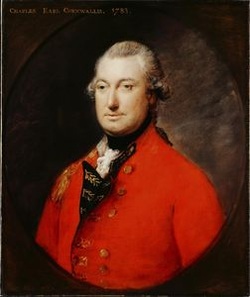Charles Cornwallis

Born:31-Dec-1738
Birthplace: London, England
Died: 5-Oct1805
Buried, Cornwallis Tomb, Ghazipur, Benares, India
Cause of death: unspecified
Charles Cornwallis, the Charles Cornwallis (1738-1805), eldest son of Charles (1700-1762), was born on the 31st of December 1738.He was promoted to a lieutenant-colonelcy in the 12th Foot. In 1762 he succeeded to the earldom and estates of his father; in 1765 he was made aide-de-camp to the king and gentlemen of the bedchamber; in 1766 he obtained a colonelcy in the 33rd Foot; and in 1770 he was appointed governor of the Tower of London.
In public life he was distinguished by independence of character and inflexible integrity; he voted without regard to party, and opposed the ministerial action against Wilkes and in the case of the American colonies. But when the American War of Independence broke out, he accompanied his regiment across the Atlantic, and served not without success as a major-general. In 1780 he was appointed to command the British forces in South Carolina. 1781 he defeated General Nathanael Greene at Guilford Court House, and made a destructive raid into Virginia; but he was besieged at Yorktown by French and American armies and a French fleet, and was forced to capitulate on the 19th of October 1781. With him fell the English cause in the United States.
He not only escaped censure, however, but in 1786 received a vacant Garter, and was appointed Governor-General of India and Commander-in-Chief in Bengal. As an administrator he projected many reforms, but he was interrupted in his work by the quarrel with Tippoo Sahib. In 1791 he assumed in person the conduct of the war and captured Bangalore; and in 1792 he laid siege to Seringapatam, and concluded a treaty with Tippoo Sahib, and placed his two sons as hostages in the hands of the English. He returned to England in 1793, received a marquisate and a seat on the Privy Council, and was made master-general of the ordinance with a place in the Cabinet. In June 1798 he was appointed to the viceroyalty of Ireland, and the zeal with which he strove to pacify the country gained him the respect and goodwill of both Roman Catholics and Orangemen.
The sites were www.nndb.com
www.americanhistory.si.edu
By: Matthew Hanson
Birthplace: London, England
Died: 5-Oct1805
Buried, Cornwallis Tomb, Ghazipur, Benares, India
Cause of death: unspecified
Charles Cornwallis, the Charles Cornwallis (1738-1805), eldest son of Charles (1700-1762), was born on the 31st of December 1738.He was promoted to a lieutenant-colonelcy in the 12th Foot. In 1762 he succeeded to the earldom and estates of his father; in 1765 he was made aide-de-camp to the king and gentlemen of the bedchamber; in 1766 he obtained a colonelcy in the 33rd Foot; and in 1770 he was appointed governor of the Tower of London.
In public life he was distinguished by independence of character and inflexible integrity; he voted without regard to party, and opposed the ministerial action against Wilkes and in the case of the American colonies. But when the American War of Independence broke out, he accompanied his regiment across the Atlantic, and served not without success as a major-general. In 1780 he was appointed to command the British forces in South Carolina. 1781 he defeated General Nathanael Greene at Guilford Court House, and made a destructive raid into Virginia; but he was besieged at Yorktown by French and American armies and a French fleet, and was forced to capitulate on the 19th of October 1781. With him fell the English cause in the United States.
He not only escaped censure, however, but in 1786 received a vacant Garter, and was appointed Governor-General of India and Commander-in-Chief in Bengal. As an administrator he projected many reforms, but he was interrupted in his work by the quarrel with Tippoo Sahib. In 1791 he assumed in person the conduct of the war and captured Bangalore; and in 1792 he laid siege to Seringapatam, and concluded a treaty with Tippoo Sahib, and placed his two sons as hostages in the hands of the English. He returned to England in 1793, received a marquisate and a seat on the Privy Council, and was made master-general of the ordinance with a place in the Cabinet. In June 1798 he was appointed to the viceroyalty of Ireland, and the zeal with which he strove to pacify the country gained him the respect and goodwill of both Roman Catholics and Orangemen.
The sites were www.nndb.com
www.americanhistory.si.edu
By: Matthew Hanson
